Year 10 Biology
Cells and Organelle
All living organisms are made up of cells
Cells are the building blocks for life
Organelle Name | Function |
Cell Membrane |
|
Cell Wall |
|
Cytoplasm | Jelly like material that other organelle are suspended in |
Mitochondria | For cellular respiration and energy production |
Chloroplast |
|
Vacuole | Stores waste |
Ribosomes | Where amino acids combine creating proteins |
Endoplasmic Reticulum |
|
Golgi Body/Apparatus | Modifies proteins in ribosomes and packages before sending them to secretion cell |
Nucleus | Contains DNA |
Lysosomes | Contains digestive enzymes, able to break down large molecules |
Centrioles | Very important for cell division |
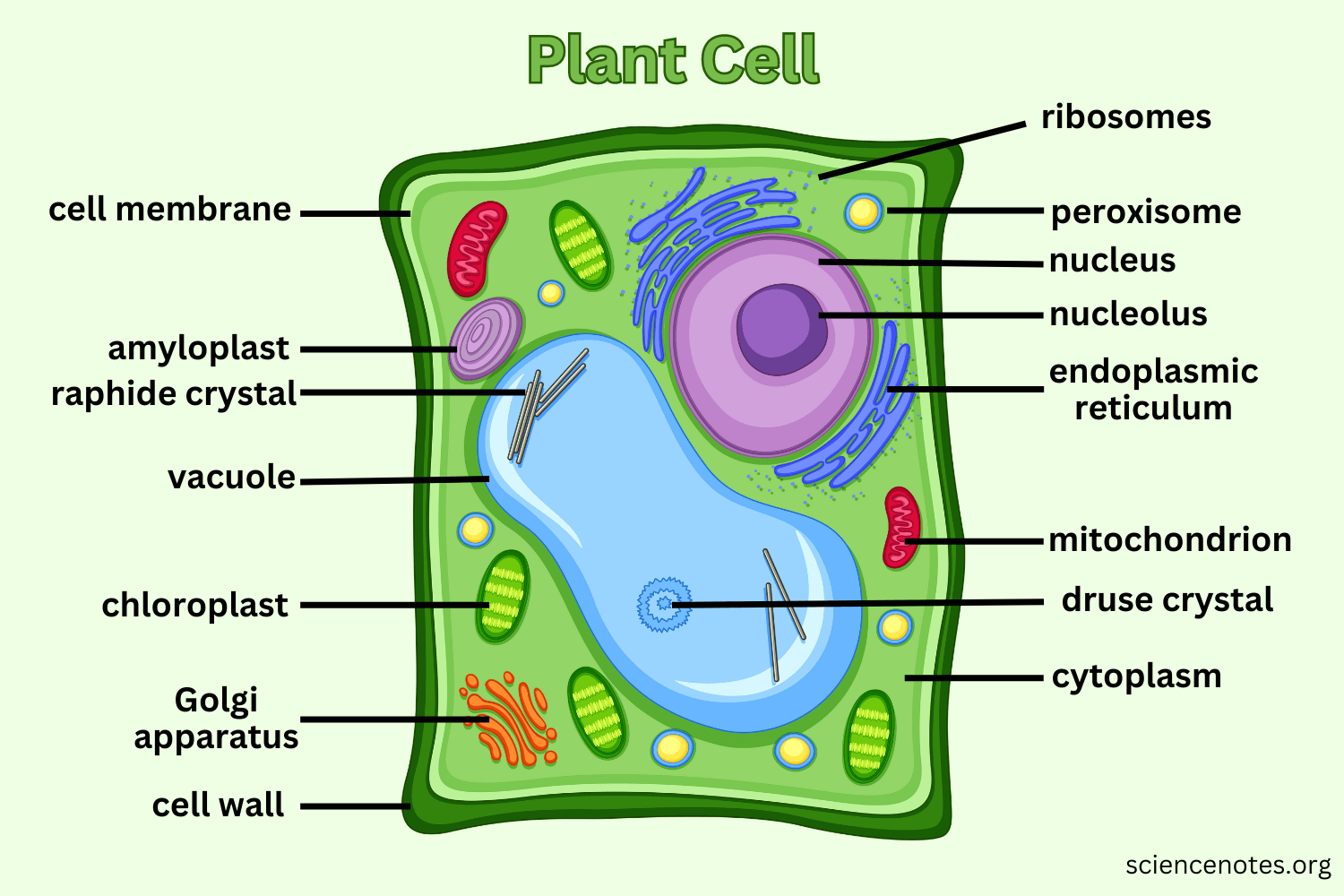
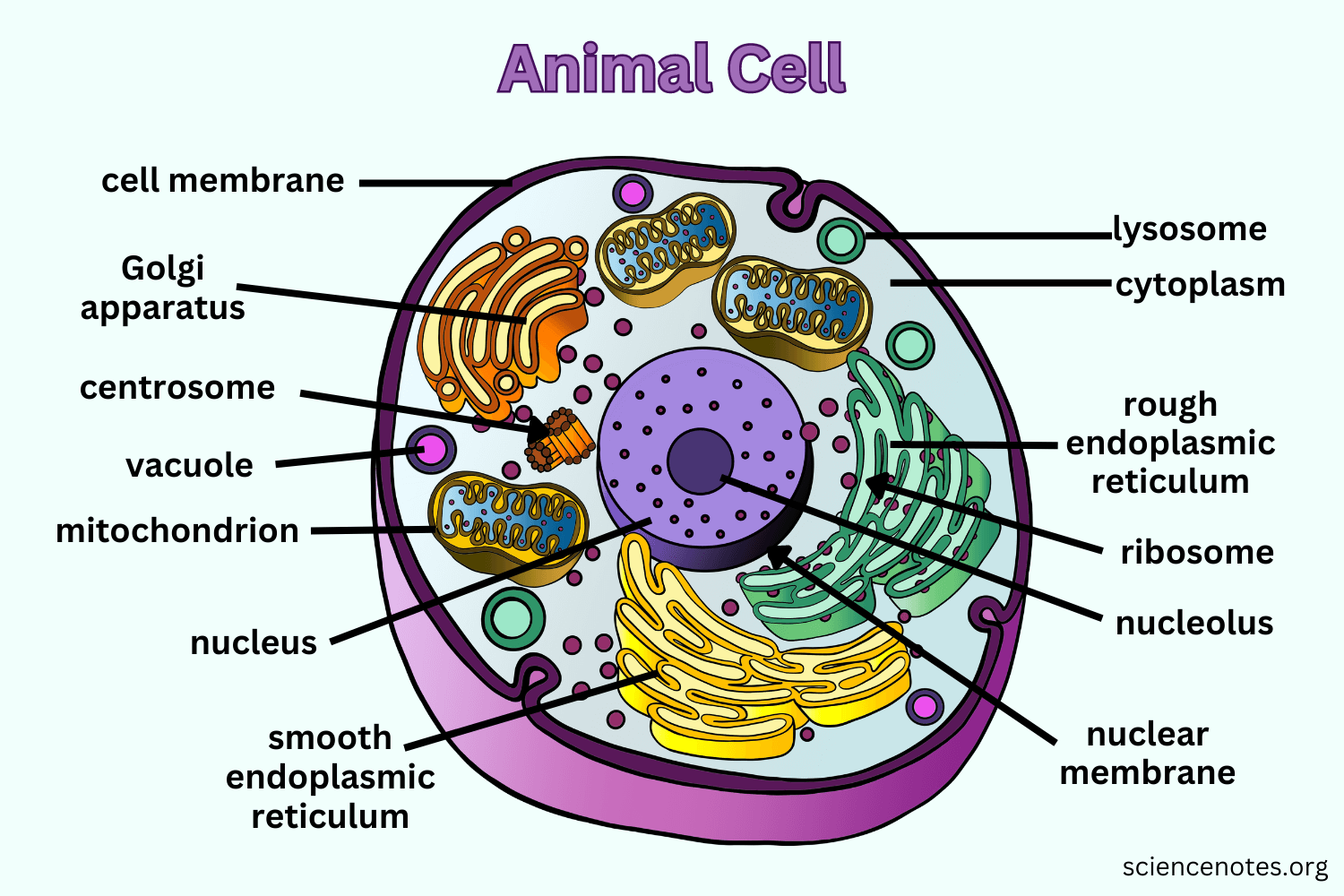
Plant Cells vs Animal Cells
Different Shapes
Plant cells contain:
Cell walls
Chloroplasts
Larger Vacuoles
DNA (Deoxyribonucleic Acid)
Carries genetic information determining the structure of cells and the way if functions
Chemical code that the cell uses to produce proteins enzymes
Found in both the mitochondria and the nucleus
A polymer - a substance made up of a large number of small substances joined together
Nucleotides
Make up DNA
Monomers - the smallest base units of a substance
Made up of a phosphate group, a sugar and a nitrogen base
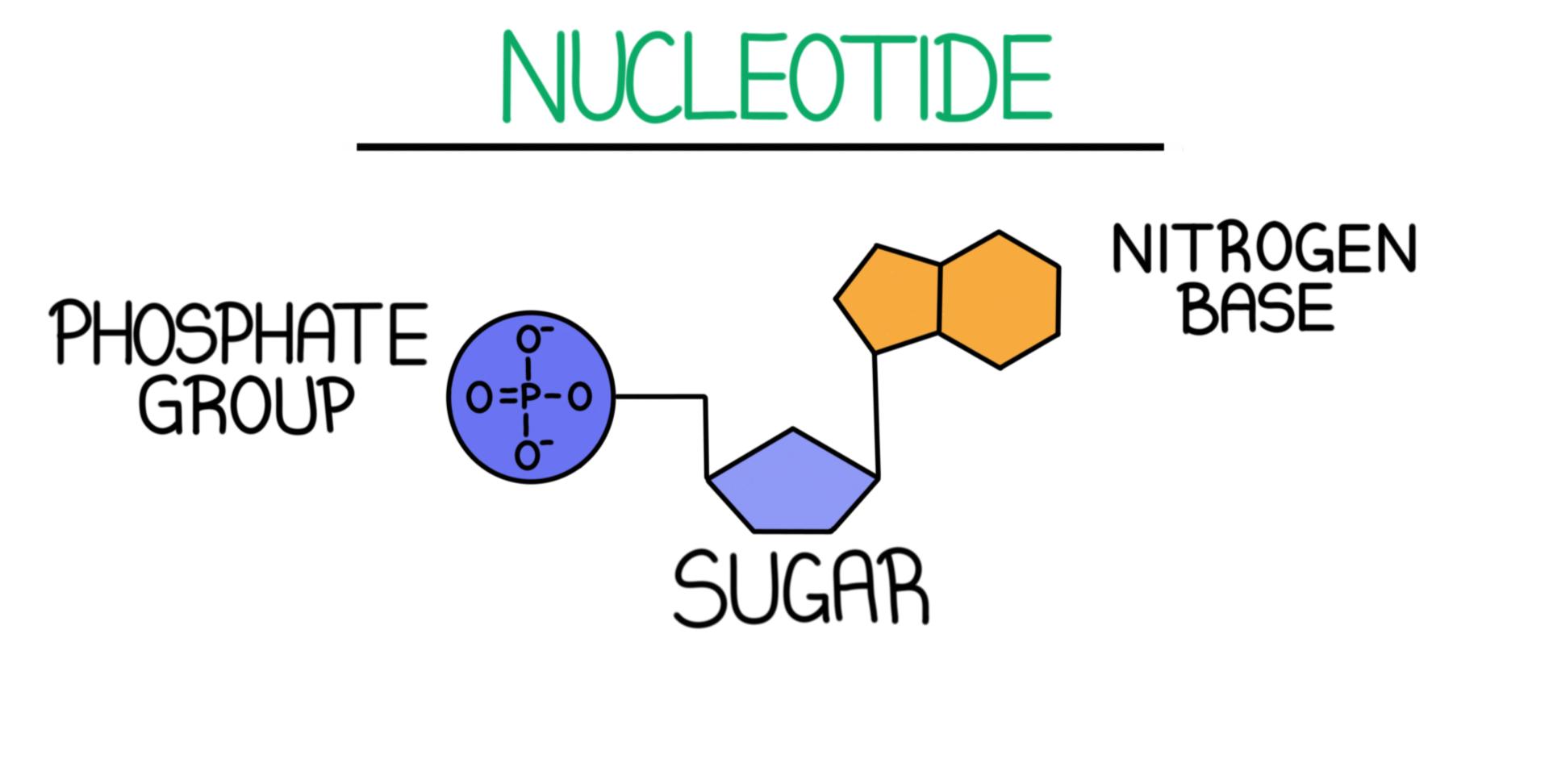
4 Nitrogenous Bases
Adenine (A)
Thymine (T)
Guanine (G)
Cytosine (C)
A and T can only bond
C and G can only bond
Protein Synthesis
Order of base pairing represents a code for making proteins
Nucleotides form a ladder (double helix structure)
Sugar and Phosphate form the uprights
Nitrogenous bases form the rungs
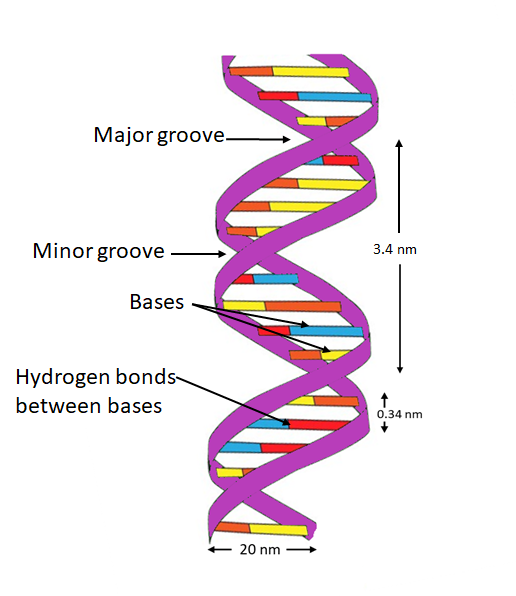
Watson and Crick were the two scientists who finalised this model
Replication
Chromosomes consist of DNA coiled around a protein (Histone)
Chromosomes can consist of 1 or 2 strands of DNA
The strand is called a chromatid
Cells divide to replace old/dead/damaged cells and create new ones so organisms can grow
Cell Division
New cells created are called Daughter cells and they need to have an exact copy of DNA from the Parent cell
DNA Replication is the first step of cell division and it ensures inherited information is passed on unchanged when new cells are formed
The 2 linked chains of DNA molecules separate or unzip and this is controlled by an enzyme called DNA helicase
Unzipped DNA molecule now has the bases exposed and they serve as a template for the nucleotides that will form the new half
DNA polymerase move along the exposed strands and adds complementary nucleotides to each nucleotide in each existing strand
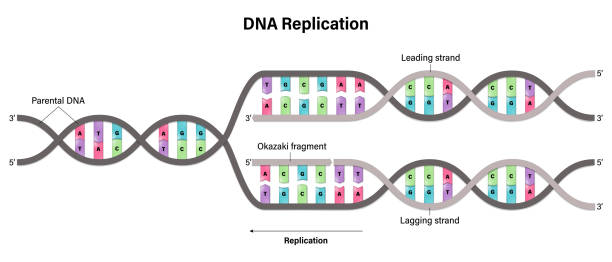
Mitosis
the process of division of the nucleus of a cell in which the two daughter nuclei have the same number and type of chromosome as the parent nucleus
makes daughter cells, which have identical copies of parent cell DNA
imperative for growth and repair of the body
happens for the first 22 pairs of chromosomes
before mitosis happens DNA replication takes place
interphase happens next, which is also not apart of Mitosis, the replicated DNA coils up forming chromosomes
4 Stages of Mitosis
Prophase
Metaphase
Anaphase
Telophase
Prophase
centrioles become visible and migrate to opposite poles, producing spindles which grow towards the chromosome
the nuclear membrane breaks down and the chromosomes become visible and they move to the centre of the cell
Metaphase
the chromosomes create a line on the cell equator and the spindle fibres attach to the centromere of each chromosomes
Anaphase
the spindle fibres retract back to the centrioles, separating the chromosomes into chromatids, pulling them to the poles of the cell
Telophase
nuclear membrane reforms and spindle fibres breakdown
Cytokinesis
the cell membrane and cytoplasm splits into two new cells
This leaves you with 2 exact replicas of the parent cell

Meiosis
Diploid cells
a body cell contains 2(set/pair) of chromosomes
referred as 2n with n= number of different chromosomes
Haploid cells (half)
in a gamete (sperm/egg cell) there is a haploid number of chromosomes
referred as n
amount of sets
Process of cell division that produces gametes (sperm/ova)
Gametes have half the amount on chromosomes that a body cell has
Homologous Chromosomes
pairs of chromosomes that are identical in size/shape/genes
each member influences the same characteristics
Aim of Meiosis
to produce haploid cells from diploid body cells
DNA Replication happens making 4 strands of DNA instead of 2 and then Interphase happen.
Meiosis 1:
Practically the same a Mitosis but is different Prophase 1
Prophase 1
Crossing over between chromatid pairs happens changing the genetic make-up
Metaphase 1
Anaphase 1
Telophase 1
Cytokinesis 1
Meiosis 2:
Is the same as Mitosis
Summary:
Meiosis is a type of cell division used to produce the gametes. It has 2 rounds of division used to create 4 haploid cells. The daughter cells are GENETICALLY DIFFERENT.
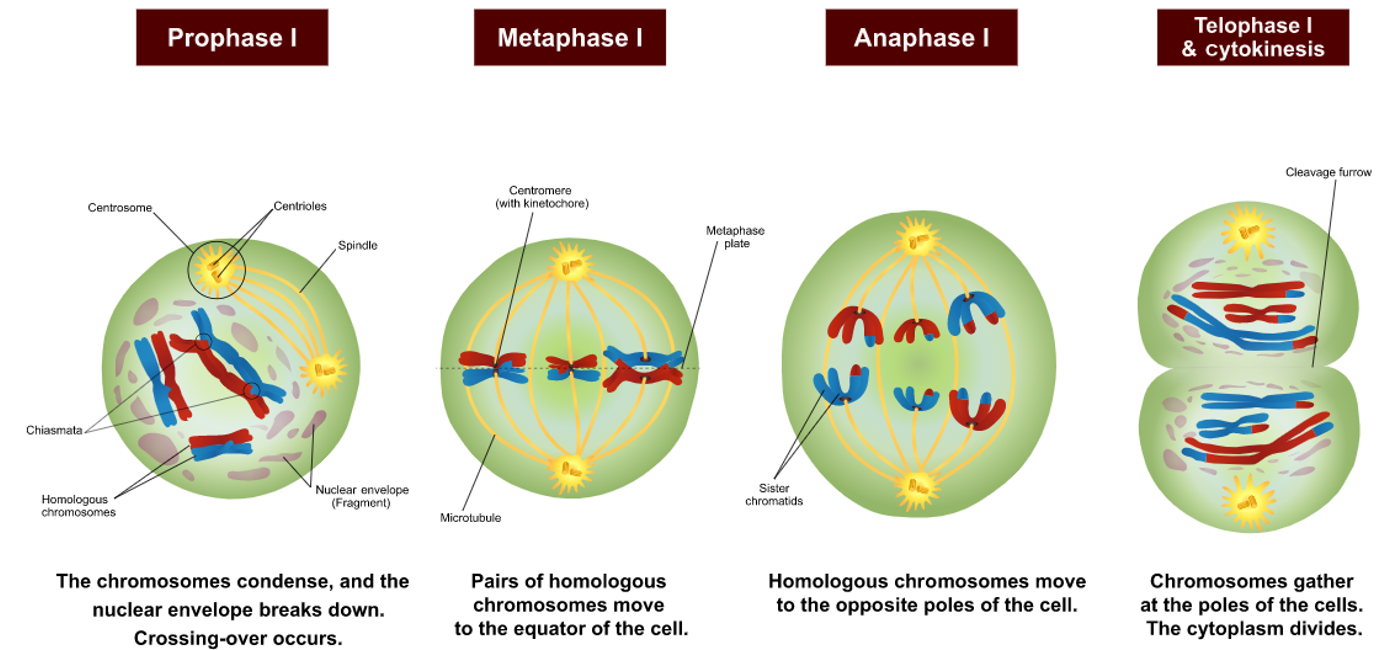
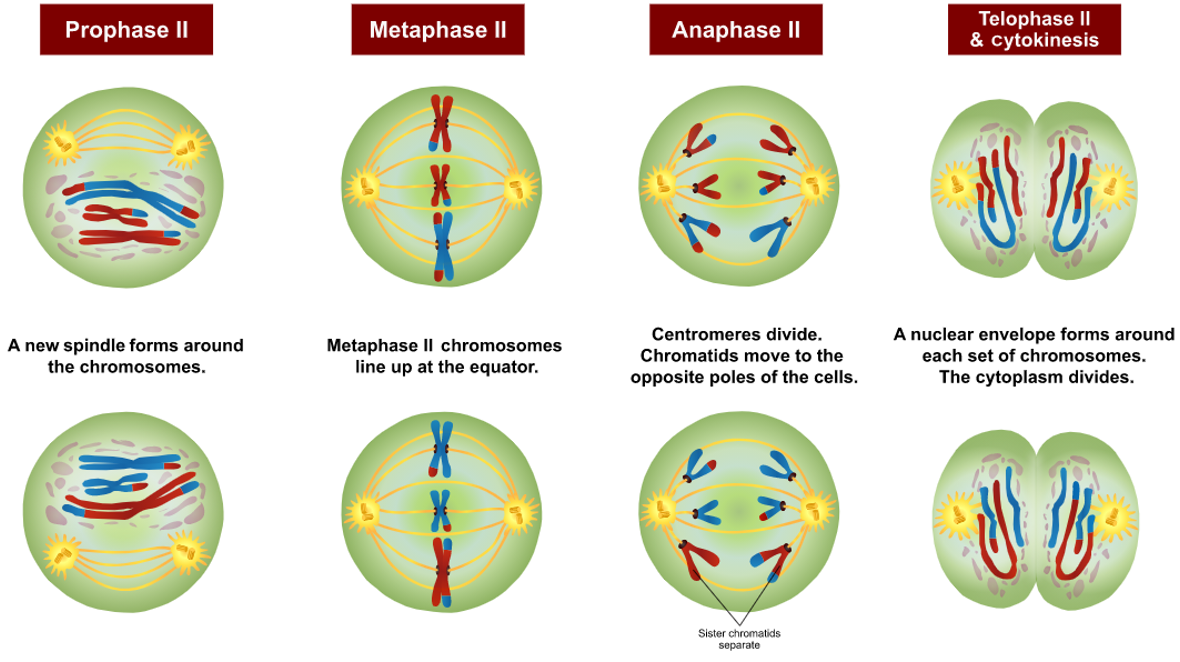
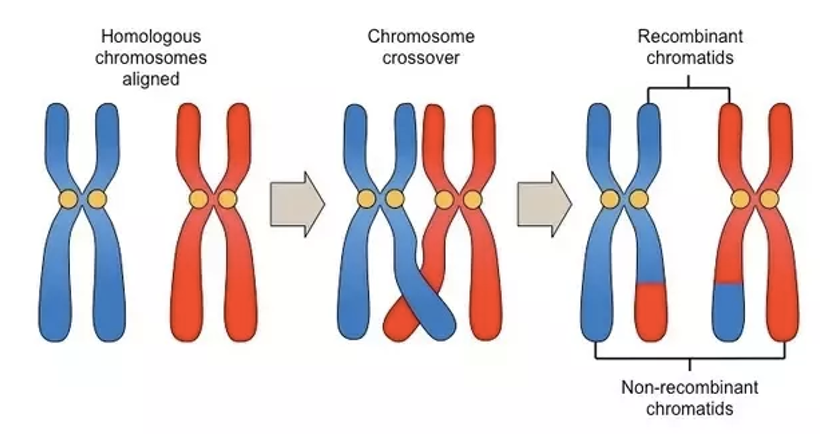
Genes and Alleles
Karyotype
the full set of chromosomes in a cell
in humans, the karyotype of a normal cell shows 46 chromosomes in 23 pairs
the 1st 22 pairs are autosomal
the 23rd pair are sex chromosomes
males have an X and a Y chromosomes
females have 2 X chromosomes
Inherited Traits
a trait is a distinguishing quality or characteristic, typically one belonging to a person
Gregor Mendel
father of genetics
worked on pea plants and concluded how genetics work, genes exist in pairs (one from each parent) and they can separate and form pairs again in the next generation
Genes
a sequence within the DNA which codes for the production of a protein and this determines a trait
difference between genes is the order of nitrogenous bases
Alleles
an alternative form/variation of a gene
the different possibilities for a given trait
each chromosome contains alleles, or different variations of the same gene
Chromosomes pair up as Homologous Pairs
they’re the same shape/size
carry genes controlling the same traits
Monohybrid Crosses
Dominant and Recessive
a dominant allele will mask the trait of a recessive allele (represented by capital letter)
a recessive allele will only be expressed if a dominant allele is not present (represented by lower case letter)
e.g. T= curly, t= straight
Tt or TT = curly
tt = straight
Genotype
genetic make up of an organism; the gene (or allele) combination an organism has
e.g. Tt, tt, TT
Phenotype
physical characteristic of an organism; the way the organism looks
e.g. curly hair or straight hair
Homozygous
2 identical alleles for a trait (dominant or recessive)
e.g. TT or tt
Heterozygous
has 2 different alleles for trait (dominant)
e.g. Tt
2 plants or animals, which differ at only one gene are bred together
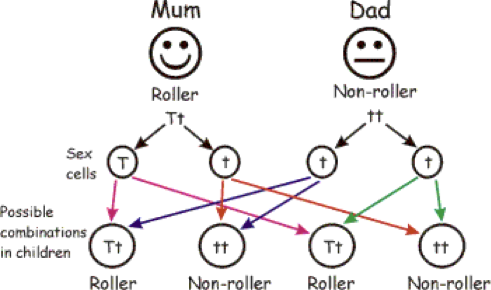
Punnet square/monohybrid crosses
diagram showing the gene combinations that might result from a genetic cross
used to calculate the probability of inheriting a particular trait
Rules
down key identifying alleles letters represent
write down parents pheno/genotypes
draw punnet square
complete cross

Sex Linked Traits/Characteristics
The Y chromosome is very small compared to the X chromosome
Y chromosomes doesn’t have the same number of genes in it as the X
most of the genes in the x chromosome, will not have a matching allele in males
the pattern of inheritance is different in males and females
characteristics affected by the genes on your x chromosome are called sex-linked characteristics or x-linked characteristics
Hemizygous
if a gene is only on the x chromosome, then males only have the one allele. this is referred to as being hemizygous for that gene.
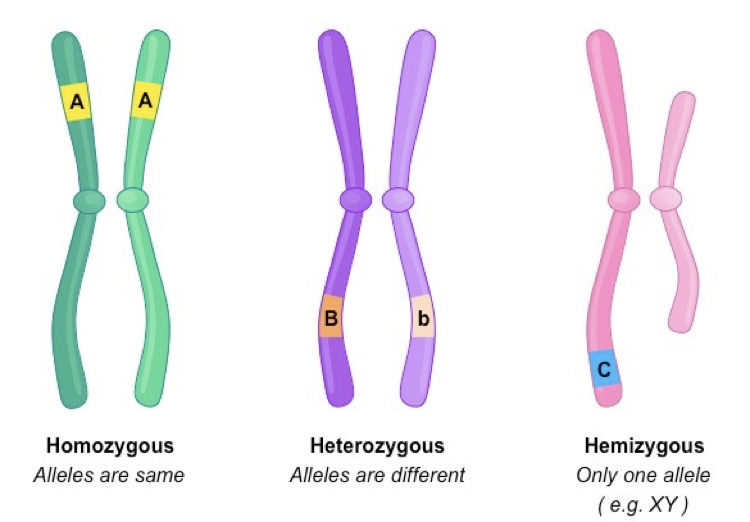
Red/Green colour blind
ability to discriminate controlled by a gene located in the x chromosome
individuals unable to distinguish have the recessive allele of this gene
more common in males then females
A colour blind male mates with a female homozygous for a regular vision kids
Pedigrees
Show the pattern of inheritance of a particular trait within a family
symbols
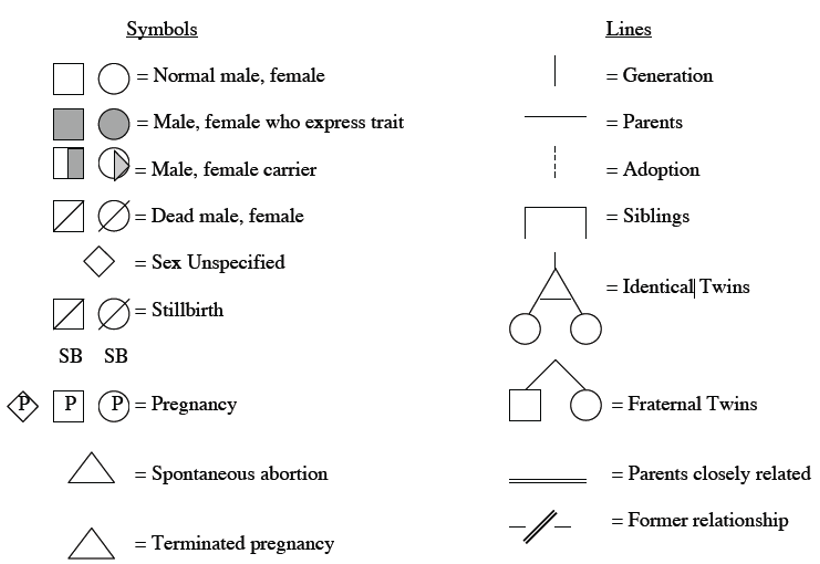
conventions
always included a title which indicates the trait and its made of inheritance
roman numerals indicate the generation
numbers represent the individuals
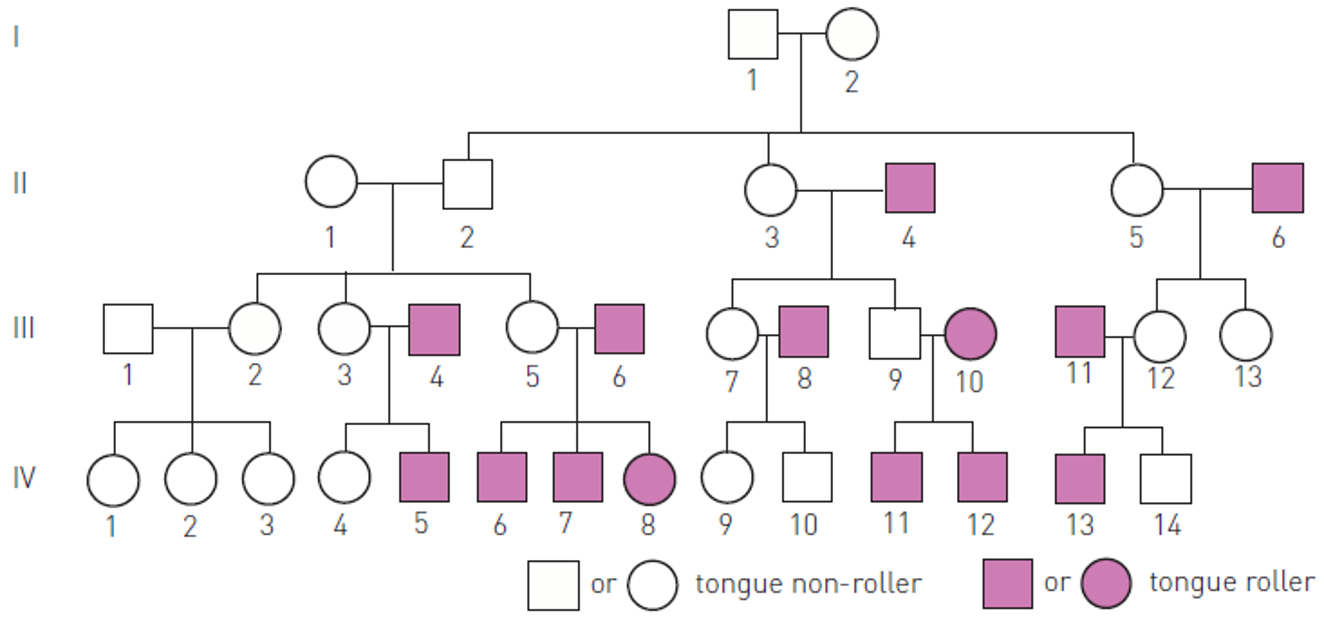
Modes of Inheritance
what you need to know
whether the trait is dominant or recessive
whether the trait is autosomal or sex-linked
look for 2 parents without the trait that have a child with the trait (recessive)
If there is none it is dominant
If recessive look at the sexes affected. If prodominantly in males it is probably sex linked if equal between sexes probably autosomal
AUTOSOMAL RECESSIVE:
· Equal chance of both sexes being affected; this tells you it is autosomal
· An affected female does not have an affected father; this tells you it is autosomal
· Each affected individual has normal parents; this tells you it is recessive
· If both parents have condition, ALL of the offspring will be affected; this tells you it is recessive
· Affected individuals must be homozygous recessive (eg rr). These are the shaded individuals.
AUTOSOMAL DOMINANT:
· Equal chance of both sexes being affected; this tells you it is autosomal
· Each affected individual has at least one affected parent; this tells you it is dominant
· About ½ of the offspring of affected individuals have the condition; this tells you it is dominant
· An unaffected individual cannot transmit an affected allele.
Unaffected individuals must be homozygous recessive (eg. rr). These are the unshaded individuals.
SEX-LINKED RECESSIVE:
· Affected individuals are usually male; this tells you it is most likely sex-linked
· An affected female MUST have an affected father; this tells you it is sex-linked
· Sons of the affected male (XrY) and normal female (XRXR) are normal
· Two parents that do not show the condition can have affected offspring; this tells you it is recessive
· Females are generally carriers (XRXr) and thus do not show symptoms of the condition.
SEX-LINKED DOMINANT:
· Affected individuals are usually female; this tells you it is most likely sex-linked
· An affected male will pass it on to all his daughters and none of his sons. this tells you it is sex-linked dominant
· A female with the trait may pass it on to both her sons and daughters.
· Every affected person has at least one affected parent. this tells you it is dominant
· Females are generally carriers (XRXr) and thus do show symptoms of the condition.
Mutations
A change in the nucleotide sequence of the DNA of the organism.
It’s random
Can be influenced by mutagens (environmental or external factor that causes a mutation):
radiation
UV light
some chemicals (asbestos, tobacco)
viruses
More likely to happen in DNA replication or meiosis.
Types of Mutation
Gene Mutation: involves an error in a singular nucleotide base and can disrupt a gene or a sequence
Chromosomal Mutations: involve an error in a group of nucleotide bases, disrupting gene/gene sequence
Gene Mutation Types
Substitution/Point: A pair is substituted for another
Frameshift: A base pair is added or deleted. This is more impactful as it’s changing the whole code by moving it up or down by one.
Chromosomal Abnormality: different amount of chromosomes due to more or less
Natural Selection
Species - a group of organisms in which its members can produce fertile offspring
Population - a group of the same species in a location. all the different types of genes in the population is known as the gene pool
Changes in gene pools
An allele is an alternative form of a gene (e.g. allele for black hair or allele for blonde hair)
Mutations, migration pressure, environmental factors are all reasons the frequency of an allele can change over time
E.g. allele frequency for the dark skin will increase in the frog population if it helps with camouflage on the logs.
Evolution - the genetic change in characteristics of a species over generations
Natural selection - the change in proportion of a particular genotype of a species over many generations due to environmental selection of a particular phenotype
Natural Selection
Driving force behind evolution
Process where an environmental factor acts on a population and results in some organisms in one species having more off spring than others
Selective agents/pressures'
The environmental factor that acts on the population
Biotic Factors (living)
Predation
Bacterial Infection
Competition
Abiotic Factors (non-living)
Temperature
Water
Soil nutrients
Fire
Survival of the Fittest
in every population there is variation (natural differences) due to individuals having different genes
the fittest or most well adapted individuals have a better chance at survival and therefore reproduce
these individuals have a survival advantage
Speciation
The process where one species is separated into two different species or more different species
Steps to Speciation
Variation
Isolation
Selection

Evidence for Evolution
Fossil Record
shows intermediate species in an evolutionary lineage
shows how more complex species developed from simpler ones over time
Comparative Embryonic Analysis
embryos of different species look similar to each other due to a shared common ancestor
Comparative Anatomy
different species show similar structural organisation because they share a common ancestor (e.g. pentadactyl limb)
DNA and Protein Evidence
species have similar genes or amino acids sequences because they share common ancestors
the closer related a species is the more amino acids sequences/genes they have in common